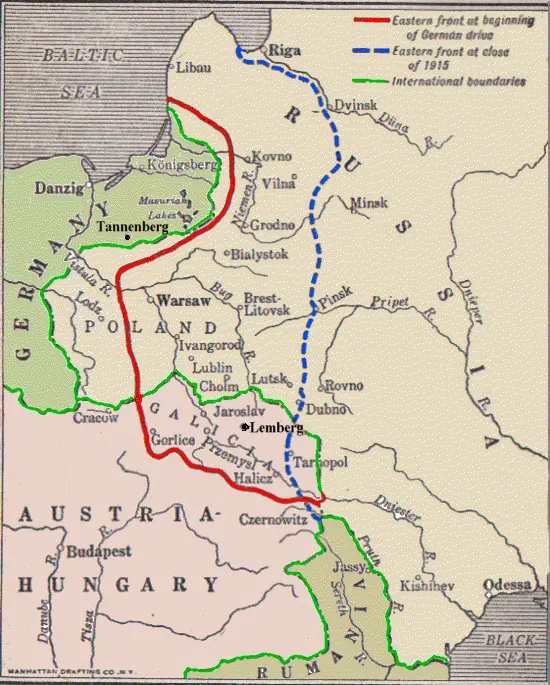The Battle of Tannenberg: Unearthing the Forgotten Epic of World War I
- kismber

- Sep 9, 2023
- 4 min read
World War I, known for its colossal battles, staggering casualties, and geopolitical upheaval, is often associated with the trenches of the Western Front. Yet, one of the most extraordinary and lesser-known chapters of this global conflict unfolded on the Eastern Front in 1914—the Battle of Tannenberg. This clash between the German Empire and the Russian Empire stands as a testament to tactical brilliance, military strategy, and the profound impact of a single engagement on the course of a world-altering war.

As the world descended into the chaos of World War I, the Eastern Front emerged as a theatre of conflict with its unique dynamics. The Russian Empire, led by Tsar Nicholas II, sought to expand its influence westward into Eastern Europe, a move that didn't sit well with the Central Powers, including Germany. The Eastern Front stretched across vast territories, where the harsh climate and logistics presented unique challenges to both sides.

The Battle of Tannenberg, which took place from August 26 to August 30, 1914, was a direct result of these geopolitical tensions. The Russian Second Army, commanded by General Alexander Samsonov, moved into East Prussia, aiming to strike a blow against the German forces. Facing this formidable Russian advance were the German Eighth Army, led by General Paul von Hindenburg, and his Chief of Staff, Erich Ludendorff.
Hindenburg and Ludendorff, relatively unknown at the time, would go on to become legendary figures in German military history. Their tactical acumen, however, would first shine at Tannenberg.
The Russian Second Army's advance seemed formidable on paper. Its numerical strength was substantial, and initial successes led to optimism among Russian commanders. However, the Russian Army faced a multitude of challenges. The vast Eastern Front made communication and supply lines tenuous. Additionally, the Russian forces were hampered by poor coordination, partly due to the indecisiveness of General Samsonov.

Hindenburg and Ludendorff recognized the weaknesses in the Russian offensive and devised a brilliant plan. They decided to split their forces, with General Maximilian von Prittwitz leading a smaller German force to engage the Russian First Army to the north. Meanwhile, Hindenburg and Ludendorff would concentrate the main German force against Samsonov's Second Army.
Prittwitz's engagement with the Russian First Army, known as the Battle of Gumbinnen, served as a diversion to keep the Russians focused to the north. Meanwhile, the bulk of the German Eighth Army, under Hindenburg's direct command, moved swiftly to intercept Samsonov's Second Army.
The heart of the Battle of Tannenberg took place near the town of Allenstein (Olsztyn), where the German Eighth Army executed a masterful encirclement of the Russian Second Army. As the Russian forces advanced, the Germans skillfully deployed their troops to encircle the Russians, creating a pocket that would become a graveyard for Samsonov's army.
The German encirclement was not without challenges. It relied on precise timing, rapid movement, and coordination among various German units. Additionally, German reconnaissance planes provided invaluable information about Russian movements.
As the German pincers closed around the Russians, chaos and confusion reigned among the encircled Russian forces. Supplies ran low, and the Russians struggled to communicate or coordinate a breakout. The German artillery and machine guns pounded the trapped Russians mercilessly.
The Russian situation was desperate, and General Samsonov, burdened by the unfolding catastrophe, reportedly exclaimed, "I have brought shame upon the Russian arms." Tragically, he took his own life amidst the chaos of the encirclement.
The Battle of Tannenberg resulted in a resounding victory for the German Eighth Army. The Russian Second Army was effectively annihilated, with estimates of Russian casualties ranging from 30,000 to over 70,000, and tens of thousands taken as prisoners of war. The Germans, by contrast, suffered relatively light casualties.

The impact of Tannenberg extended beyond the battlefield. It was a morale booster for the Central Powers, showing that they could triumph against the formidable Russian Army. For the Russians, the defeat at Tannenberg was a significant blow to their early war efforts and a harbinger of the challenges they would face on the Eastern Front.
The Battle of Tannenberg had profound consequences. It marked the rise to prominence of Hindenburg and Ludendorff, who would go on to play key roles in the German war effort. It also demonstrated the potential of encirclement tactics, which would become a hallmark of German military strategy in both World Wars.
Strategically, Tannenberg's impact rippled through the Eastern Front. It delayed the Russian advance into East Prussia, providing the Germans with valuable time to reinforce their Eastern Front defenses. It also had wider implications as it shaped perceptions of Russia's military capabilities and contributed to the narrative of Russian ineptitude in the early stages of the war.
In the grand tapestry of World War I, the Battle of Tannenberg may occupy a relatively modest space, but its significance is undeniable. It was a clash of brilliant strategy, military innovation, and the harsh realities of war on the Eastern Front. Tannenberg's lessons, both tactical and strategic, left an indelible mark on the conflict and the military leaders who emerged from its crucible.
While Tannenberg may not share the same prominence as battles like Verdun or the Somme, its story serves as a compelling reminder that the annals of history are rich with forgotten epics waiting to be unearthed and remembered.



